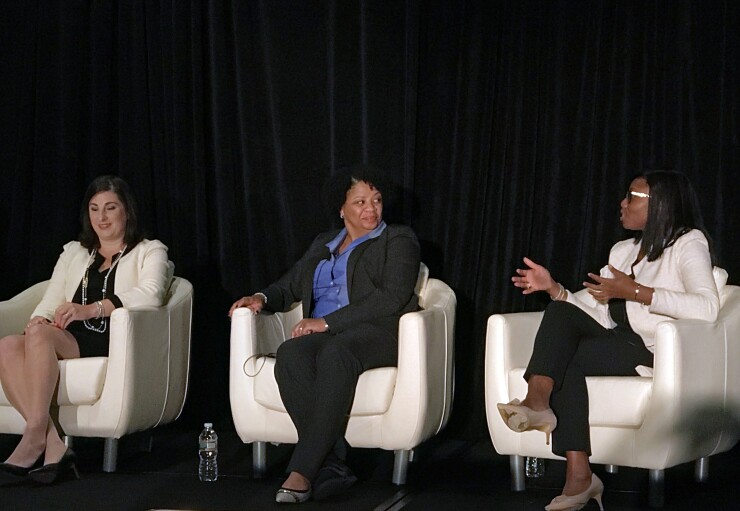BOSTON — To ensure investments in technology succeed, asset managers are being urged to marry such resources with more robust human capital management. One industry trade association has pledged to support efforts to attract and retain talent, while firm administrators are breathing new life into dated employee evaluation processes with gaming programs for assessments.
Deciding whether to pay market rate for a 20-something quant analyst — which now averages nearly $250,000 annually — is just one of the many challenges, said Yabu Sesay, executive director of global HR at JP Morgan Asset and Wealth Management.
"We want the greatest minds delivering for our business," Sesay said on a panel of HR executives from Vanguard and Northern Trust at NICSA's 2017 General Membership Meeting in Boston. "That is out of the scope for the typical junior role [at our firm]. But the market said this position is worth X. Do we want to pay that? What makes sense from that standpoint?"

At JPMorgan, Sesay said emphasis has been placed on developing tools to evaluate both new and existing employees. She mentioned the development of a tool, still in the testing phase, known as "gaming," which is designed to better understand their employees' strengths and weaknesses through a series of decision-making tests.
"[Employees] set up profiles, then leverage that tool ... with games they play on how they resolve [various issues]," she said. "I'm excited about it. A couple others are using it in the industry ... and that's a change for us. Whether we do that for more of the senior roles, I don't know."
AGE GAP MEASURES
Hiring talent has become a numbers game — and not just in juggling the dollars it takes to hire a senior- level manager or new recruit, but also in how to appeal to the age gap that exists across the financial services industry.
"When you think about the boomers, there's a retiree every 90 seconds, and we have a knowledge gap for the people that have been tenured," said panelist Sonia Davis, a senior vice president and corporate HR executive at Northern Trust.
-
The company is evaluating ways to package both its quantitative and active strategies into the funds, according to a person familiar with the matter.
September 25 -
To encourage a budding relationship with younger clients, firms must provide new offerings and more guidance about how to invest, Schwab says.
September 18 -
Clients will flock to digital advice, but conditions favor incumbent firms, a study found.
September 18
"Those joining earlier are not as tentative, as they change jobs up until the age of 40. We have to capitalize on what are the key drivers that will get people to stay."
Regardless of the number of years employees have accrued in experience, the key is to appropriately compensate those adding value to the company, Davis said."You have to identify what people can bring to the table and what skills they have," she said.
EDUCATION FOCUS
In a discussion on strategies relating to educating employees in areas including automation and other changes in the industry, panelists said new technology should include a renewed focus on education.
"The days of walking into a classroom with colleagues with the dreaded roleplay and breakout session are over," said Katherine Martini Miles, an HR business partner for financial advisor services at Vanguard.
Which upgrades are attracting clients and yielding real results for firms? Find the answers in the results from FP's annual Tech Survey.
Setting aside dated performance ratings is one method Sesay hopes will take hold with the proliferation of new technology. "As we think about technology with newer generations coming in, their expectations are much higher compared to ours," Sesay said. "It's about both [generations], not just one or the other."
NICSA COMMITTEE
NICSA, a nonprofit industry trade association, has taken its own steps to increase the attention to human capital management.
While it is still in the development phase, NICSA President Jim Fitzpatrick said he is hopeful a committee will one day provide members with additional resources and expand its own reach across the industry as well.
"The goals of the committee are to provide a forum for industry human capital management professionals to collaborate on industry best practices, develop a network to facilitate communication broadly within their firms regarding NICSA member benefits and to serve as the drivers of education, training and certification requirements," Fitzpatrick said following the meeting. "That's something the board and I are looking at strategically and will be mapping out over the next six to 12 months."
Once launched, representatives from 15 to 20 of its 25 member firms will regularly meet to discuss the benefits of sharing new ideas and best practices as they relate to HR personnel, training professionals and corporate communications specialists.
Actionable steps intended by the committee will include educational training surrounding new technology and strategies, collaboration with member firms and a forum to discuss new ideas.
Aside from the educational value its members will take home from participating, the focus will ultimately result in new recruits and expansion of membership, said Fitzpatrick.
"We tend to historically work with line managers and leaders, but they don't naturally have the responsibility or ability to spread the word of NICSA membership to their entire organization," Fitzpatrick said.






